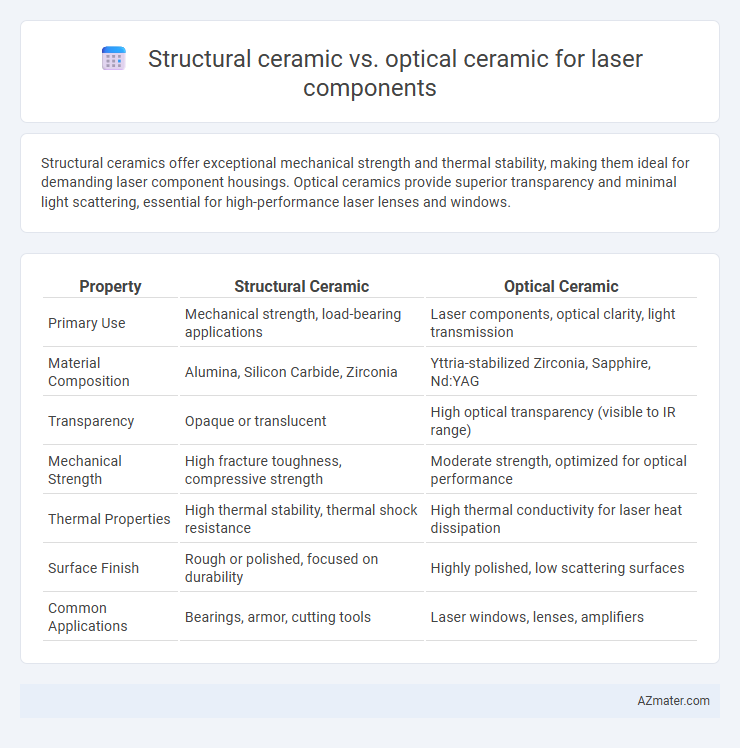Structural ceramics offer exceptional mechanical strength and thermal stability, making them ideal for demanding laser component housings. Optical ceramics provide superior transparency and minimal light scattering, essential for high-performance laser lenses and windows.
Table of Comparison
| Property | Structural Ceramic | Optical Ceramic |
|---|---|---|
| Primary Use | Mechanical strength, load-bearing applications | Laser components, optical clarity, light transmission |
| Material Composition | Alumina, Silicon Carbide, Zirconia | Yttria-stabilized Zirconia, Sapphire, Nd:YAG |
| Transparency | Opaque or translucent | High optical transparency (visible to IR range) |
| Mechanical Strength | High fracture toughness, compressive strength | Moderate strength, optimized for optical performance |
| Thermal Properties | High thermal stability, thermal shock resistance | High thermal conductivity for laser heat dissipation |
| Surface Finish | Rough or polished, focused on durability | Highly polished, low scattering surfaces |
| Common Applications | Bearings, armor, cutting tools | Laser windows, lenses, amplifiers |
Introduction to Laser Component Ceramics
Laser component ceramics are critical materials designed to withstand high thermal and mechanical stresses during laser operation. Structural ceramics offer exceptional hardness, high melting points, and resistance to wear, making them suitable for mechanical support and housing in laser systems. Optical ceramics provide superior transparency, controlled refractive indices, and minimal scattering, ensuring efficient light transmission and high optical performance in laser components such as lenses and windows.
Overview of Structural Ceramics
Structural ceramics, renowned for their exceptional hardness, high-temperature resistance, and mechanical strength, are widely used in demanding applications such as aerospace, automotive, and armor systems. These materials, including alumina, silicon carbide, and zirconia, provide durability and wear resistance essential for components exposed to extreme stresses and corrosive environments. Unlike optical ceramics, structural ceramics prioritize mechanical performance over optical clarity, making them ideal for load-bearing and protective applications in laser system housings and related hardware.
Key Properties of Optical Ceramics
Optical ceramics for laser components exhibit superior transparency, high laser-induced damage threshold, and exceptional homogeneity compared to structural ceramics, which prioritize mechanical strength and thermal stability. Key properties include low scattering loss, uniform refractive index, and excellent resistance to thermal shock and contamination, enabling precise light transmission and minimal distortion in high-power laser applications. These characteristics make optical ceramics essential for lenses, windows, and laser gain media where optical clarity and durability under intense laser exposure are critical.
Structural Ceramics in Laser Applications
Structural ceramics in laser applications provide exceptional mechanical strength, thermal stability, and wear resistance, making them ideal for supporting and protecting sensitive optical components in high-power laser systems. Materials such as alumina (Al2O3) and silicon carbide (SiC) offer superior hardness and thermal conductivity, ensuring structural integrity under intense laser irradiation and thermal cycling. Their ability to maintain dimensional stability and resist deformation enhances the durability and precision of laser equipment, crucial for consistent performance in industrial and scientific laser operations.
Optical Ceramics for Laser Systems
Optical ceramics for laser systems offer superior transparency, high damage thresholds, and excellent homogeneity, making them ideal for advanced laser components like lenses, windows, and laser gain media. These ceramics provide precise control over refractive index and minimal scattering, essential for high-power laser applications and stable beam quality. Compared to structural ceramics, optical ceramics prioritize optical clarity and performance, enabling efficient laser transmission and enhanced durability under intense laser irradiation.
Performance Comparison: Structural vs Optical Ceramics
Structural ceramics exhibit superior mechanical strength, thermal stability, and wear resistance, making them ideal for high-stress laser component applications. Optical ceramics, on the other hand, provide exceptional transparency, low scattering, and high laser-induced damage thresholds essential for precise light transmission and beam quality. Performance comparison reveals structural ceramics excel in durability and thermal management, while optical ceramics prioritize clarity and optical purity for optimal laser efficiency.
Optical Transparency and Laser Efficiency
Optical ceramics used in laser components exhibit superior optical transparency compared to structural ceramics, allowing for efficient light transmission and minimal scattering. This transparency is critical for maximizing laser efficiency by reducing energy loss and enhancing beam quality. In contrast, structural ceramics prioritize mechanical strength and thermal stability, often sacrificing optical clarity necessary for optimal laser performance.
Thermal and Mechanical Stability
Structural ceramics exhibit superior mechanical stability with high fracture toughness and excellent resistance to wear and corrosion, making them ideal for load-bearing laser components. Optical ceramics, such as yttria-stabilized zirconia or alumina, offer enhanced thermal stability and low thermal expansion coefficients, crucial for maintaining precise optical properties under laser irradiation. Both types provide critical benefits, but optical ceramics excel in maintaining dimensional and refractive stability during high-power laser operation.
Cost and Manufacturing Considerations
Structural ceramics for laser components typically offer lower manufacturing costs due to simpler processing techniques and higher material availability, making them suitable for applications where mechanical strength is prioritized over optical clarity. Optical ceramics require more precise fabrication methods, such as hot isostatic pressing and advanced polishing, which increase production expenses but yield superior transparency and optical performance essential for laser beam transmission. Cost considerations heavily depend on the required laser component specifications, balancing budget constraints against the performance demands of optical versus structural ceramic materials.
Future Trends in Ceramic Laser Components
Structural ceramics in laser components prioritize mechanical strength and thermal stability, while optical ceramics emphasize high transparency and minimal light scattering for superior laser performance. Future trends focus on developing hybrid ceramics combining enhanced mechanical properties with advanced optical clarity to improve durability and efficiency in high-power laser applications. Innovations in nanostructuring and doping techniques are driving the creation of multifunctional ceramic laser components with tailored refractive indices and increased resistance to laser-induced damage.

Infographic: Structural ceramic vs Optical ceramic for Laser component
 azmater.com
azmater.com